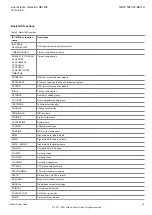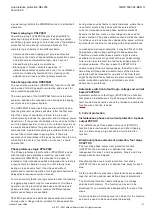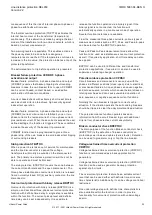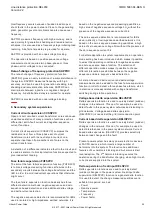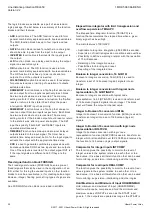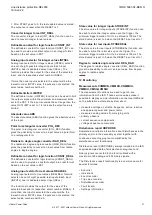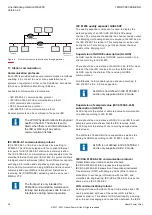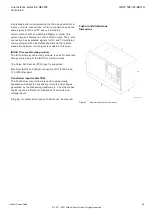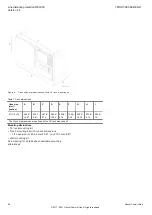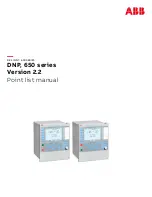
Overfrequency occurs because of sudden load drops or
shunt faults in the power network. Close to the generating
plant, generator governor problems can also cause over
frequency.
SAPTOF measures frequency with high accuracy, and is
used mainly for generation shedding and remedial action
schemes. It is also used as a frequency stage initiating load
restoring. A definite time delay is provided for operate.
SAPTOF is provided with an undervoltage blocking.
The operation is based on positive sequence voltage
measurement and requires two phase-phase or three
phase-neutral voltages to be connected.
Rate-of-change of frequency protection SAPFRC
M14965-3 v14
The rate-of-change of frequency protection function
(SAPFRC) gives an early indication of a main disturbance in
the system. SAPFRC measures frequency with high
accuracy, and can be used for generation shedding, load
shedding and remedial action schemes. SAPFRC can
discriminate between a positive or negative change of
frequency. A definite time delay is provided for operate.
SAPFRC is provided with an undervoltage blocking.
8. Secondary system supervision
Current circuit supervision CCSSPVC
M12444-3 v10
Open or short circuited current transformer cores can cause
unwanted operation of many protection functions such as
differential, earth-fault current and negative-sequence
current functions.
Current circuit supervision (CCSSPVC) compares the
residual current from a three phase set of current
transformer cores with the neutral point current on a
separate input taken from another set of cores on the
current transformer.
A detection of a difference indicates a fault in the circuit and
is used as alarm or to block protection functions expected to
give inadvertent tripping.
Fuse failure supervision FUFSPVC
SEMOD113820-4 v13
The aim of the fuse failure supervision function (FUFSPVC)
is to block voltage measuring functions at failures in the
secondary circuits between the voltage transformer and the
IED in order to avoid inadvertent operations that otherwise
might occur.
The fuse failure supervision function basically has three
different detection methods, negative sequence and zero
sequence based detection and an additional delta voltage
and delta current detection.
The negative sequence detection is recommended for IEDs
used in isolated or high-impedance earthed networks. It is
based on the negative-sequence measuring quantities, a
high value of negative sequence voltage 3U
2
without the
presence of the negative-sequence current 3I
2
.
The zero sequence detection is recommended for IEDs
used in directly or low impedance earthed networks. It is
based on the zero sequence measuring quantities, a high
value of zero sequence voltage 3U
0
without the presence of
the zero sequence current 3I
0
.
For better adaptation to system requirements, an operation
mode setting has been introduced which makes it possible
to select the operating conditions for negative sequence
and zero sequence based function. The selection of
different operation modes makes it possible to choose
different interaction possibilities between the negative
sequence and zero sequence based detection.
A criterion based on delta current and delta voltage
measurements can be added to the fuse failure supervision
function in order to detect a three phase fuse failure, which
in practice is more associated with voltage transformer
switching during station operations.
Voltage based delta supervision DELVSPVC
GUID-6188C4C1-E1D5-421A-B496-96676287EBB2 v2
Delta supervision function is used to quickly detect (sudden)
changes in the network. This can, for example, be used to
detect faults in the power system networks and islanding in
grid networks. Voltage based delta supervision
(DELVSPVC) is needed at the grid interconnection point.
Current based delta supervision DELISPVC
GUID-30A00AE0-8D3A-4CE8-9379-8D1A0A6078E3 v2
Delta supervision function is used to quickly detect (sudden)
changes in the network. This can, for example, be used to
detect disturbances in the power system network. Current
based delta supervision (DELISPVC) provides selectivity
between load change and the fault.
Present power system has many power electronic devices
or FACTS devices, which injects a large number of
harmonics into the system. The function has additional
features of 2
nd
harmonic blocking and 3
rd
harmonic start
level adaption. The 2
nd
harmonic blocking secures the
operation during the transformer charging, when high inrush
currents are supplied into the system.
Delta supervision of real input DELSPVC
GUID-8FAD2CCF-091F-4CDB-8ABF-1BDC874A8403 v2
Delta supervision functions are used to quickly detect
(sudden) changes in the power system. Real input delta
supervision (DELSPVC) function is a general delta function.
It is used to detect the change measured qualities over a
settable time period, such as:
• Power
• Reactive power
• Temperature
• Frequency
• Power factor
Line distance protection REL650
1MRK 506 384-BEN H
Version 2.2
Hitachi Power Grids
25
© 2017 - 2021 Hitachi Power Grids. All rights reserved
Содержание REL650 series
Страница 1: ...Relion 650 SERIES Line distance protection REL650 Version 2 2 Product guide...
Страница 117: ...117...









